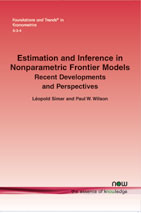Estimation and Inference in Nonparametric Frontier Models: Recent Developments and Perspectives
By Léopold Simar, Institut de Statistique, Biostatistique et Sciences Actuarielles, Université Catholique de Louvain, Belgium, leopold.simar@uclouvain.be | Paul W. Wilson, Department of Economics and School of Computing, 228 Sirrine Hall, Clemson University, USA, pww@clemson.edu
Abstract
Nonparametric estimators are widely used to estimate the productive efficiency of firms and other organizations, but often without any attempt to make statistical inference. Recent work has provided statistical properties of these estimators as well as methods for making statistical inference, and a link between frontier estimation and extreme value theory has been established. New estimators that avoid many of the problems inherent with traditional efficiency estimators have also been developed; these new estimators are robust with respect to outliers and avoid the well-known curse of dimensionality. Statistical properties, including asymptotic distributions, of the new estimators have been uncovered. Finally, several approaches exist for introducing environmental variables into production models; both two-stage approaches, in which estimated efficiencies are regressed on environmental variables, and conditional efficiency measures, as well as the underlying assumptions required for either approach, are examined.
Estimation and Inference in Nonparametric Frontier Models
Estimation and Inference in Nonparametric Frontier Models provides a thorough examination of this topic for students and researchers alike. While nonparametric estimators are widely used to estimate the productive efficiency of firms and other organizations, it is often done without any attempt to make statistical inference. Recent work has provided statistical properties of these estimators and methods for making statistical inference has established a link between frontier estimation and extreme value theory. New estimators that avoid many of the problems inherent with traditional efficiency estimators have been developed and these new estimators are robust with respect to outliers and avoid the problem of dimensionality. In addition, statistical properties, including asymptotic distributions, of the new estimators are uncovered. Finally, the authors show several approaches for introducing environmental variables into production models.
